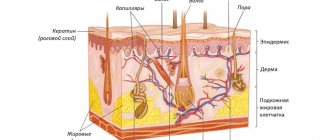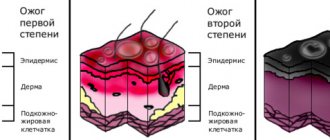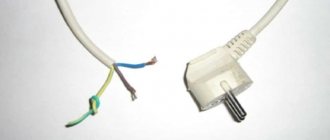Electric shock occurs when you come into contact with an electrical circuit that contains voltage sources and/or current sources that can cause current to flow through the energized part of the body. Typically, a person is sensitive to passing a current of more than 1 mA. In addition, in high-voltage installations, an electric shock is possible without touching live elements, as a result of current leakage or breakdown of the air gap. The strength of the injury depends on the power of the discharge, on the time of exposure, on the nature of the current (direct or alternating), on the condition of the person - the moisture of the hands, etc., as well as on the place of contact and the path of current passage through the body.
Due to the high electrical resistance of human tissues, they heat up quite quickly, which can cause burns. Even relatively small stresses, with short-term contact with the chest, can cause a malfunction of the heart muscle. An electric shock can cause problems in the nervous system, such as erratic muscle contractions. Repeated impacts can cause neuropathy. If the head is hit by an electric current, loss of consciousness may occur.
At sufficiently high voltages and currents, so-called electric arcs can occur, causing severe thermal burns. The electric arc also produces strong light emissions.
Saving the life of a person struck by an electric current largely depends on the speed and correctness of the actions of those assisting him. First aid should be provided immediately, if possible at the scene of the incident, while simultaneously calling medical help.
The person providing assistance should know:
- main signs of violation of the vital functions of the human body;
- general principles of first aid and its techniques in relation to the nature of the injury received by the victim;
- the main methods of carrying and evacuating victims.
The person providing assistance must be able to:
- assess the condition of the victim and determine what kind of help he needs in the first place;
- ensure free patency of the upper respiratory tract;
- perform artificial respiration “mouth to mouth” (“mouth to nose”) and closed cardiac massage and evaluate their effectiveness;
- determine the advisability of calling the victim by ambulance or passing transport.
First aid sequence:
1. Eliminate the impact on the body of damaging factors that threaten the health and life of the victim (free from electric current, remove from a contaminated atmosphere, extinguish burning clothing, etc.), assess the condition of the victim; 2. Determine the nature and severity of the injury, the greatest threat to the life of the victim and the sequence of measures to save him; 3. Carry out the necessary measures to save the victim in order of urgency (restore airway patency, perform artificial respiration, external cardiac massage); 4. Support the victim’s basic vital functions until a medical professional arrives; 5. Call an ambulance or take measures to transport the victim to the nearest medical facility.
In case of electric shock, death is often clinical (“imaginary”), so you should never refuse to provide assistance to the victim and consider him dead due to lack of breathing, heartbeat, or pulse.
Only a doctor has the right to decide on the feasibility or safety of measures to revive the victim and make a conclusion about his death.
Types of impact
The body can simultaneously undergo the following actions:
Thermal effects, expressed in the formation of burns on certain areas of the skin, an increase in body temperature, an effect on the functioning of the heart, blood vessels and other important organs.
Electrolytic influence is characterized by the breakdown of fluids in the body and changes in the structure of the blood.
With biological damage, the structure of muscle and nervous tissue changes. The heart muscles and lungs are subjected to severe stress, the consequences of which lead to a lack of heartbeat or difficulty breathing.
The mechanical consequences of the impact of an electric discharge are expressed in the separation and detachment of tissues, which are a consequence of the electrodynamic shock.
Let's take a closer look at damage caused by electric current and methods of rescue.
What is a first degree burn?
A first degree burn is a mild injury. It is characterized by redness of the skin, slight swelling, and mild pain. The temperature may rise locally. With a 1st degree burn, only the upper layers of the epidermis are affected, and the deeper layers of the skin and subcutaneous fatty tissue are not affected.
After providing primary medical aid (first aid), such burns heal without a trace within a few days in adults and a little longer in children. But to prevent a minor injury from growing into a big problem, you need to know what to do in case of a 1st degree burn, and how to properly provide first aid.
Types of damage
Injuries resulting from the action of electric current on a person are divided into two categories:
- local type;
- general type.
The list of first injuries includes electric shock to bones, ligaments and various parts of the skin.
Treatment of electrical burns
Low-voltage electrical burns received at home most often affect a small area and are located on the hands and feet, sometimes in the corners of the mouth, and on the lips. They usually heal within 7-10 days.
To speed up the regeneration process of injured skin, use special healing products. The La-Cri cream for sensitive skin, which contains natural non-hormonal components, has proven itself to be excellent. Its complex composition allows you to simultaneously influence all manifestations of inflammation. The product copes well with skin irritations, promotes rapid healing of burns, and is suitable for adults and children.
Treat the inflamed area with La-Cri cream 1-2 times a day until complete healing, and soon you will forget about irritation. The main thing is to remember the safety rules when using electrical appliances.
Metallization of the skin
Manifests itself under the influence of electric arc discharges. Particles of molten metal tend to penetrate under the upper skin of a person.
This exposure is not fatal, but may cause discomfort. It is much more dangerous than metal particles getting into the eyes, since subsequent treatment does not guarantee a positive result.
Mechanical damage to body parts
An electrical discharge running through a healthy body affects the uniform contraction of muscle tissue. This leads to mechanical injuries. This includes local skin tears, dislocations and fractures. Moreover, a fracture as a result of a fall and as a result of an electric shock are two different things.
The result of mechanical damage after exposure to electric current is complex long-term treatment with the help of highly qualified doctors.
What problems does a multifunctional voltage and current relay solve?How to choose an electrical panel housing for your home?
- Electrical network design
Features of electrical burns
The main danger of electric shock is that electrical burns are a highly unpredictable injury. Unlike a thermal burn, for example, when you touch a hot iron and immediately feel pain, when receiving an electric shock there is no pain.
The burned area loses sensitivity, and a so-called electrical mark (sign) appears at the point of contact with the current source - an area of reddened or charred skin (depending on the degree of the burn). It is usually gray or brown in color and has a slight indentation in the center; marks are oval, rounded and in the form of stripes (when struck by lightning).
General electrical injuries
They are divided into electric shock and electric shock.
Electric shock is an effect on organic tissue through an electric current, resulting in a sharp muscle contraction. A person who has received an electric shock appears distracted at first and has memory problems.
Even if the victim is not diagnosed with serious consequences after the blow, the person’s immunity ultimately suffers. In the future, heart complications and neurological diseases may appear.
Electric shock has the following categories:
- first - muscle cramps occur, while the person is conscious without any deviations;
- second - along with uneven changes in muscles, a person loses consciousness, while the work of the heart and respiratory system is stable;
- third - with loss of consciousness, a slowdown in heart rate and breathing occurs;
- the fourth is the most severe, in which no signs of life are observed, breathing and pulse stop, and death occurs.
Electric shock refers to the severe consequences of exposure to electric current. First, a person experiences a period of excitement, during which the person does not feel pain, but only feels an increase in blood pressure. After some time, the pressure drops, the heartbeat increases, and the victim goes into a depressive state. This period can last from a quarter of an hour to a day.
Who can carry out electrical work?- Workwear for an electrician: what to choose, requirements, standards
Insulation resistance: how to measure basic characteristics, standard and check of protection level
Recovery is facilitated only by timely and professional treatment. If you do not provide first aid in case of electric shock, the consequences will be much worse.
Educational program on electrical injuries: from burns and cataracts to fractures and fibrillation
In the comments to our article about the death of a Malaysian schoolboy wearing headphones, we promised to make a post about electrical injuries, as well as the peculiarities of the pathogenic effect of electric current on the organs and tissues of the human body. We promised - we deliver.
The post was prepared in collaboration with dlinyj, who acted as a reviewer and consultant on issues of the physics of electricity and labor protection, as well as co-author of the section “What kills current or voltage?” Under the cut, I described in detail the mechanisms of electrical injury, medical consequences, and also analyzed several tragic cases associated with unusual electrical injuries. In preparing the material, I used my own medical experience, facts known from the media, as well as literature and documents available on the Internet (photos of lesions contained in the article may be considered shocking and unacceptable by some readers).
Moderator warning. The publication contains images of body parts of traumatized people, which can affect the mental state of sensitive adults and children.
What kills: current or voltage?
Let's start with this holivar-forming question, without which, perhaps, not a single popular post about electrical injury can do.
Without much deliberation, I’ll write that the main damaging factor is current, it’s what kills. As we all know from school physics course, current = voltage/resistance. I believe that it is correct to say that voltage (potential difference) is a condition for damage, but in itself does not cause damage. For example, the voltage of static discharges when removing a woolen sweater reaches several kilovolts, but they do not cause any significant damage, since the current is negligible. Therefore, in such cases, tension is compared with height, which in itself does not lead to death and cannot be its cause, in contrast to the very fact of falling, in which height becomes a significant condition for the occurrence of death.
It is worth remembering what electric current is.
As the Russian name suggests, current is a flow, that is, the flow of charged particles. How many of them flow per unit time through a unit cross-section of a conductor. The greater the number of particles, the greater the current. It is the flow of particles that causes human injury. The amount of current that can pass through a person is determined by the applied voltage, the internal resistance of the current source, and the resistance of the person's body. As a rule, current (and voltage) sources have an output current several orders of magnitude higher than lethal for a person, and in this case, the determining factor in the magnitude of the current is the resistance of the human body and the magnitude of the applied voltage. The resistance of the human body depends on the individual characteristics of the person and his physical condition. For example, a sweaty person has a very low resistivity, and there have been cases when a person was killed by the voltage at the contacts of a regular battery. dlinyj
Electrical trauma according to WHO standards, tissue processes and severity of injury
Today in various literature you can find a lot of classifications and definitions of electric shock to a person - they are all interesting, but they bring a lot of confusion.
In my opinion, we should adhere to the generally accepted definition adopted by WHO. Thus, according to WHO standards, electric shock is usually called electrical injury (no shocks or other types of injury are distinguished separately). According to WHO standards, any injury is physical damage to organs and tissues that occurs under the influence of one or another type of energy. Therefore, electrical injury is any damage (impaired activity) caused by exposure to current, that is, electrical energy.
Types of current exposure
There are three types of effects of electric current on the body, which fall under the definition of electrical injury:
- biological - irritation and excitation of muscle and nerve fibers, disruption of bioelectric processes;
- thermal - burns and heating of tissue under the influence of current;
- electrolytic - a change in the physicochemical composition and properties of biological fluids (blood, lymph, cerebrospinal fluid, etc.).
Electric current can damage all tissues and organs without exception.
The skin, peripheral and central nervous systems, muscles, tendons, and cardiovascular system are primarily affected. It hits bones, joints, and gastrointestinal tract organs somewhat less frequently, but if it hits, it hits hard, almost certainly. Severity of defeat
So, we list the factors on which the severity of electrical injury depends:
- current path, localization of the lesion;
- the magnitude of the damaging current (A);
- type of current (alternating or direct);
- current frequency (Hz);
- body resistance (Ohm);
- humidity and air temperature (as the temperature rises, sweating begins, which reduces body resistance);
- condition of the skin (presence of wounds, skin diseases, sweat, etc.);
- Tension is also taken into account when assessing, but contrary to the established stereotype, it does not have a decisive significance.
Body resistance
Body resistance is perhaps one of the most important and most difficult factors. It is variable and depends on complex biochemical and biophysical characteristics, tissue properties at the current time, and environmental characteristics. In other words, this is one of the factors that makes any prediction of electric shock (with a known magnitude) comparable in accuracy to the theological treatises of the 14th century or the predictions of Nostradamus.
The table below shows the resistance ranges of the tissues of our body; from it it is easy to understand that the values vary over a very wide range.
Classification of currents by type of impact
The magnitudes of the damaging current are conventionally divided into 3 ranges, depending on the predominant effect the current has. Thus, currents are released:
- imperceptible - from 0.5 - 1.5 mA;
- felt - 3 mA - the effect of the current is felt tactilely;
- releasing - 6 mA - causes muscle spasm, while grabbing the conductor, the affected person can release it;
- non-releasing - from 10 to 15 mA - the affected person cannot release the conductor without assistance;
- asphyxiating from 25 to 50 mA - can cause paralysis of the respiratory center;
- fibrillation from 100 to 200 mA - causing fibrillation (random contraction) of the heart chambers - one of the types of cardiac arrest.;
*Sometimes the so-called “thermal” or “thermal” - low direct currents (from 5 A), causing a feeling of warmth, burning.
The table below correlates the ranges of alternating and direct current values and the damage that they can cause (given, according to the manual of S.G. Novikov, associate professor of the Department of Environmental Engineering and Occupational Safety of the Moscow Energy Institute).
Current paths
Another important and often decisive factor is the current path, which depends on the entry and exit points of the discharge. The most dangerous routes are those that pass through vital organs (brain and spinal cord, heart, lungs, liver, kidneys). Typical cases of electrical injury through headphones are when the current path flows through the head (almost all known incidents resulted in death).
If the current path does not pass through vital organs, then the influence on them occurs exclusively as a reflex, and accordingly, the danger to vital functions is much less. Current paths through the human body are sometimes called loops. The most dangerous of them are considered: “arm-arm” (40% of deaths), “head-legs” and “head-arm” (together about 20%), “right arm-legs” (20%), “left arm -legs" (17%), other deaths account for approximately 3%.
The table below shows the percentage of damaging electrical current passing through the heart for various current paths:
A little about the mechanism of tissue damage
According to Ilisheva, after the current overcomes the resistance of the skin, it penetrates the tissue and causes electrolysis, which, in turn, leads to an imbalance in the ionic balance in cellular formations. Rapid tissue necrosis during electrical trauma is caused precisely by the polarization of cell membranes during electrolysis. The following happens:
- ions with a positive charge are concentrated at the anode, the environment becomes acidic;
- An accumulation of negatively charged ions occurs at the cathode, which provokes an alkaline reaction.
These processes of ion concentration change the state of cells and lead to coagulation necrosis in areas with an acidic reaction and colliquation in areas with an alkaline reaction.
When a current acts on nerve fibers, perineural edema, necrosis (death) of neuronal structures, and thrombosis of surrounding vessels are observed. Similar processes occur in muscle tissue. Before the development of necrosis, the nervous tissue is irritated, and tone and convulsive contractions occur in the muscles, which in turn lead to mechanical damage (see below).
The skin is affected mainly at the points where the charge enters and exits; thermal phenomena can cause burns and inclusions of foreign metal particles (see below), and the electrochemical effect of the current can cause changes in the color of the skin (see current marks).
Types of electric shock
Some authors distinguish three types of electrical injuries, namely local, general and mixed.
Local injuries include burns, electrical marks (tags), metallization of the skin and mechanical damage. General are those electric shocks in which general symptoms are expressed, in the form of damage to the central nervous and cardiovascular systems. Mixed ones have characteristics of both local and general. In fact, such a division is very arbitrary. Most often, mixed electrical injuries occur. Their percentage is significantly higher than the 50% stated in some occupational safety manuals, which were obviously written by people who have not dealt with electrical injuries in practice. For 9 years in disaster medicine, I have only encountered mixed types. I believe that this happens due to the fact that an electric shock that can cause local damage will certainly lead to the development of general symptoms. Therefore, I think it is more correct to talk about local and general manifestations of electrical trauma, but not about local and general electrical trauma.
Electrical burns
Among local manifestations, the so-called electrical burns, which are divided into contact and arc. I write “so-called”, due to the fact that the burn is caused by the high temperature of the conductor or the flame of the electric arc, i.e. in fact, it is thermal, but is burdened by other damaging factors of electrical trauma.
Contact ones develop when the skin comes into direct contact with the surface of the conductor, where due to the high current density and skin resistance, the temperature locally increases. They are characterized by a relatively small affected area (usually 1% of the skin or less) with varying depths of damage and severity of the condition.
Electrical contact arc burns
, often more severe, are often accompanied by extensive 50% or more, and deep (up to degree 4) lesions. This is due to a higher temperature, and also, often, a larger area of damage. Arc burns often cause burn shock and burn disease. In cases of electrical injury from gadgets and household appliances - arc burns - the thing is not so brutal, since the arc is often small, and, accordingly, the affected area is smaller.
Arc electrical burns
Current marks
The marks (aka signs) are gray or yellowish oval-shaped spots with a small depression in the center. Signs can appear immediately or over time; cases have been described when they disappeared without a trace. This sign often occurs with severe general symptoms at the sites of entry and exit of the charge. Does not require special care, but can be used as a valuable diagnostic sign.
Current marks on the palm
Current marks after a lightning strike
Metallization
Metallization is the intradermal (located in the thickness of the skin) penetration of small metal particles that have melted under the action of an electric arc. The metal heated by the arc, damaging the upper layers of the skin, quickly cools down, transferring heat to the very heat-intensive skin and hardens in a thermocoagulated burn surface (in a scab).
metallization
With minor, shallow (down to the germ layer of the skin) skin lesions, metallization may disappear without a trace, as well as the pain associated with it, but more often these lesions are deeper and leave scars.
Eye lesions
Metallization of the cornea of the eye is especially dangerous.
Such damage leads to temporary, long-term treatment, and sometimes incurable blindness. Local ophthalmological manifestations can also include clouding of the lens (cataract), which sometimes occurs when a discharge passes through the head. Paired stellate cataract after electrical trauma
Fractures and other mechanical damage
Interestingly, electrical trauma can lead to severe mechanical damage, for example, dislocations, ligament ruptures, fractures, and also cause bleeding from damaged vessels. The main cause of such damage is considered to be convulsions that develop as a result of the irritating effect of current.
Thus, the Malaysian schoolboy we wrote about experienced bleeding where the skin came into contact with the headphones.
Bleeding from the ear after an electrical injury through headphones
In 2017, in Pervouralsk, a case of fractures of the forearm bones was recorded in a child as a result of an electrical injury. Mechanical damage due to electric shock does not include injuries received indirectly, for example, when falling after receiving an electric shock.
General manifestations
The general effect of the current leads to disruption of the functioning of vital organs and systems; the current can affect all human organs and tissues. Depending on the factors described above, the effect can be completely different in severity and severity of the clinic.
There are 4 degrees of severity of electric shock:
- 1st - convulsions with preserved consciousness;
- 2nd - convulsions with loss of consciousness, but without breathing or circulatory problems;
- 3rd - convulsions combined with loss of consciousness, as well as breathing disorders (tachypnea, dyspnea) and (or) cardiac activity (arrhythmia, tachycardia);
- 4th - clinical death, usually resulting from fibrillation or damage to the respiratory center (located in the medulla oblongata).
*Clinical death - lack of breathing, cardiac activity, consciousness. *Fibrillation is random contraction of the heart chambers.
Gadgets and electrical injuries
The widespread use of gadgets has led to a significant increase in the number of electrical injuries sustained in everyday life.
It is quite natural that all of them are caused by gadgets charging from the network, and, often, in situations where the user carelessly neglects electrical safety rules. There are many similarities between similar cases. While conducting a small content analysis of cases over the past 8 years, I noticed that most occur in developing countries with a hot, humid climate (China, India, Malaysia, Brazil). In the vast majority of cases, the cause of damage is a gadget charging from a low-quality charger with problematic galvanic isolation. In these countries, frame house construction with metal supporting structures is common, to which floor coverings are attached using conductive elements. In total, I counted 42 cases of this type of electrical injury. Regions with a hot climate, a relatively low standard of living and cheap frame houses included 36.
Below I will give only the most famous and high-profile incidents; I will not hide the fact that when making this selection, I tried to give examples close to the case in Malaysia (headphones + smartphone + charger), in order to demonstrate that they are not isolated and are 100% lethal:
Malaysian incident, 2022. Teenager, headphones, charging smartphone.
Brazil, 2022. Case of a girl and headphones (possibly the influence of lightning) India, 2022. Electrical injury in headphones (woman, 46 years old.
India, 2022. Electrical injury with headphones (Tad Singh, male, 22 years old)
Electrical injury when disconnecting the smartphone from the USB cable. Case in an Internet cafe in Wuhan, China - 2016, (teenager, Internet cafe, smartphone, PC).
Malaysia 2022. Case with a smartphone connected to a power outlet.
London. Electric shock from a charging smartphone in the bathroom (male, 32 years old)
China. Coma due to electrical trauma - 2013, charging smartphone.
China, 2022. Teenage girl, 14 years old, damaged USB cable for smartphone charger.
Let me emphasize once again that all cases of electrical injury through headphones that I know of are fatal, which confirms the danger of head-limb loops.
One of the situations described above was recorded on video in China in 2016.
While disconnecting the smartphone from the PC, the gamer received a fatal shock. I was especially struck by the behavior of those around me, who practically did not provide assistance. The video is not recommended for viewing by children and the impressionable.
In all cases, except for the Brazilian one (where there was probably a lightning strike), grounding was involved (through bathtubs, flooring elements, a grounded metal table).
One way or another, all such cases fit into existing ideas about electrical injuries and confirm much of what was written above. With detailed analysis, the apparent paradox turns into a completely ordinary story for burn centers, intensive care units and pathology bureaus.
Bottom line
I sincerely hope that the educational program presented was helpful.
We will be grateful if you share your opinion in the comments. Perhaps you have experienced an electrical injury or its consequences, or you regularly encounter this at work, tell others about your experience. Perhaps there will be another post regarding first aid - write if this is relevant to you. Photo content used:
steemit.com/comedy/@grow-pro/finding-my-funny-ass-underwater-flooding-and-funny-gifs-w-grow-pro www.intechopen.com/books/forensic-medicine-from-old- problems-to-new-challenges/epidemiology-and-diagnostic-problems-of-electrical-injury-in-forensic-medicine cdn.intechweb.org/pdfs/19164.pdf accessmedicine.mhmedical.com/content.aspx?bookid= 1763§ionid=125437574&jumpsectionid=125437642 vpr.sdamgia.ru/problem?id=807 ppt-online.org/44358
Advertising load We sell electronics, a lot of different ones. If you follow the operating rules, the electronics we sell do not cause electric shock. Moreover, we do not know of a single case in which our customers received electrical injuries from goods purchased from us.
Help with electric shocks
Only timely and correct decisions can save a person’s life. First aid should be provided with complete isolation of the current source. It may be located at a significant distance from the scene of the incident.
In this case, you need to quickly get out of the electric discharge with the victim, using materials that are dielectrics. For example, wooden flooring or rubber products are good protection against damage.
Then immediately call doctors and begin providing first aid by performing a heart massage. After this, wait for medical workers, monitoring the condition of the victim. Remember that a person’s life may depend on your prompt and correct actions.











